
Greenhouses are essential for any gardener who intends to make the most of the fluctuating climate in the northern & southern hemispheres where winters can drag on for a long time (and will continue to do so more and more as we enter deeper into the Grand Solar Minimum), preventing a lot of desirable plants from developing ahead of the spring in a way that gives them the longest possible growing season.
The land featured in this post is super hot and over exposed in the summer, super cold and frozen in the winter.
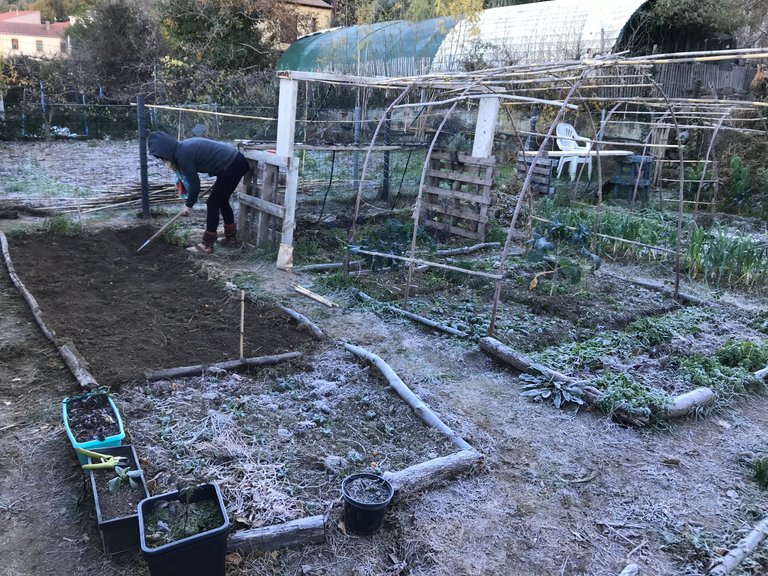
Some of you may remember how I solved the super hot summer problem with canopies of pumpkins, supported on hazelnut wood arches.

It worked perfectly, creating that extra bit of shade while growing a ton of pumpkins.
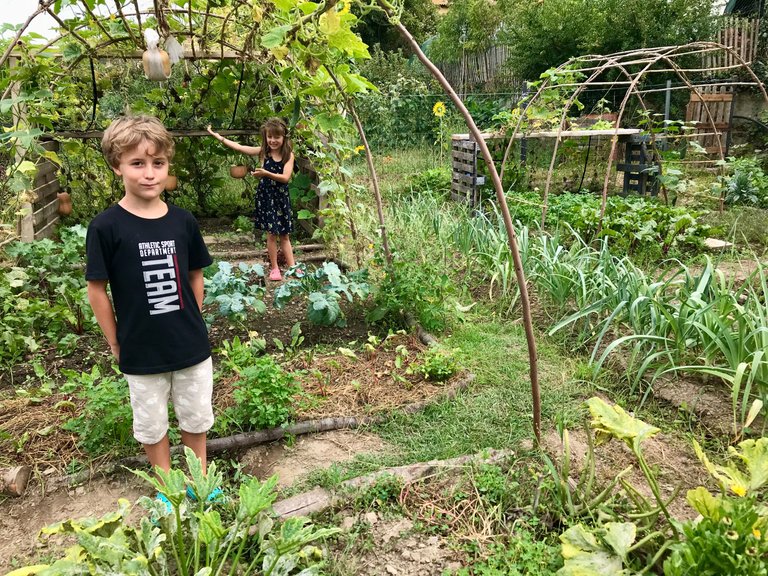
But what about the time of year when your water tub looks like this?
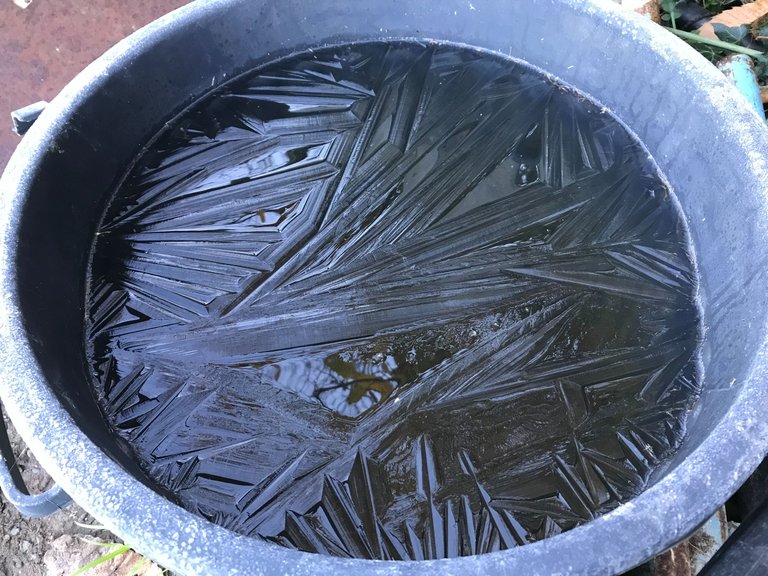
In truth I have only planted things here which will survive the winter (like these lettuce), but I am keen none-the-less to see what happens when they are enclosed within a greenhouse.
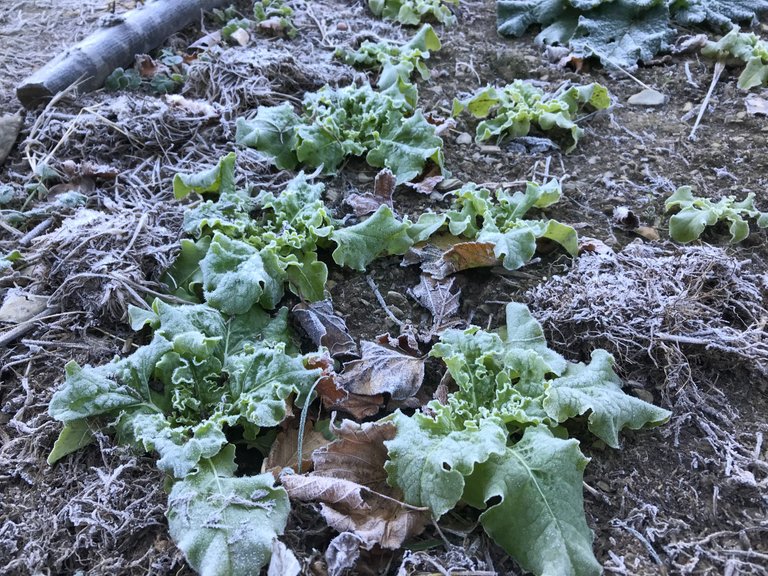
Sabrina told me recently about friends of hers using industrial cling film for this purpose, so I thought I would give this a go. It is the kind you use to wrap large items on a pallets, thicker than standard kitchen cling film.
This roll was €10 for 200m.
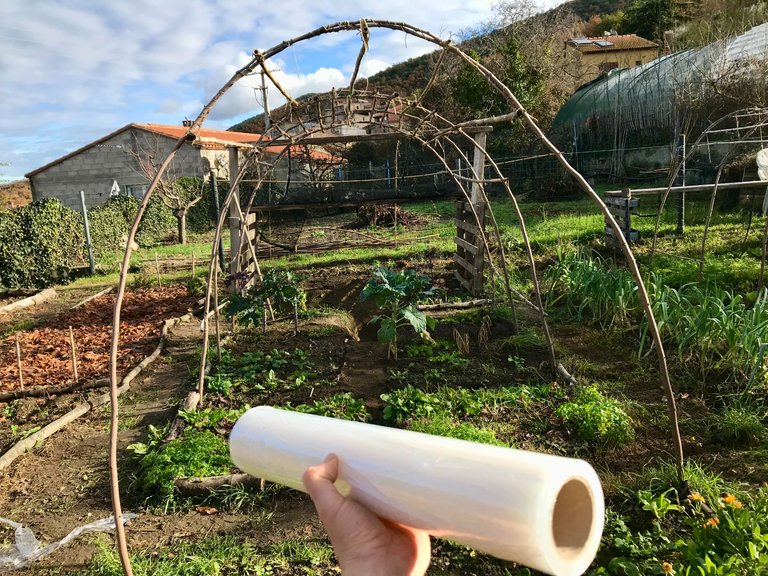
I have been looking at my arches for the last week, thinking about how best to wrap them, playing it through in my head over and over to find not only the simplest way to get this done but also the most secure and likely to survive the entire winter.
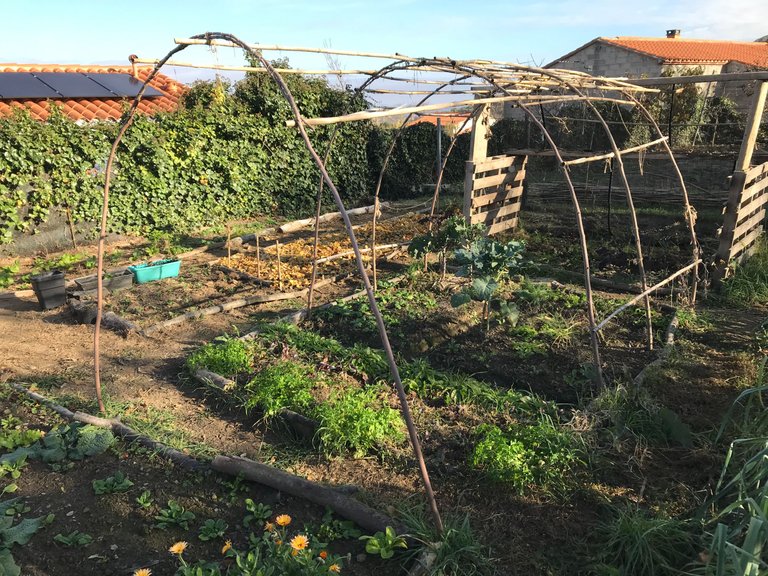
I couldn't figure out at first if I should involve this back bit with the pallets. It was useful getting the pumpkins off the ground up onto the roof of the structure, but not sure if it fits for this.
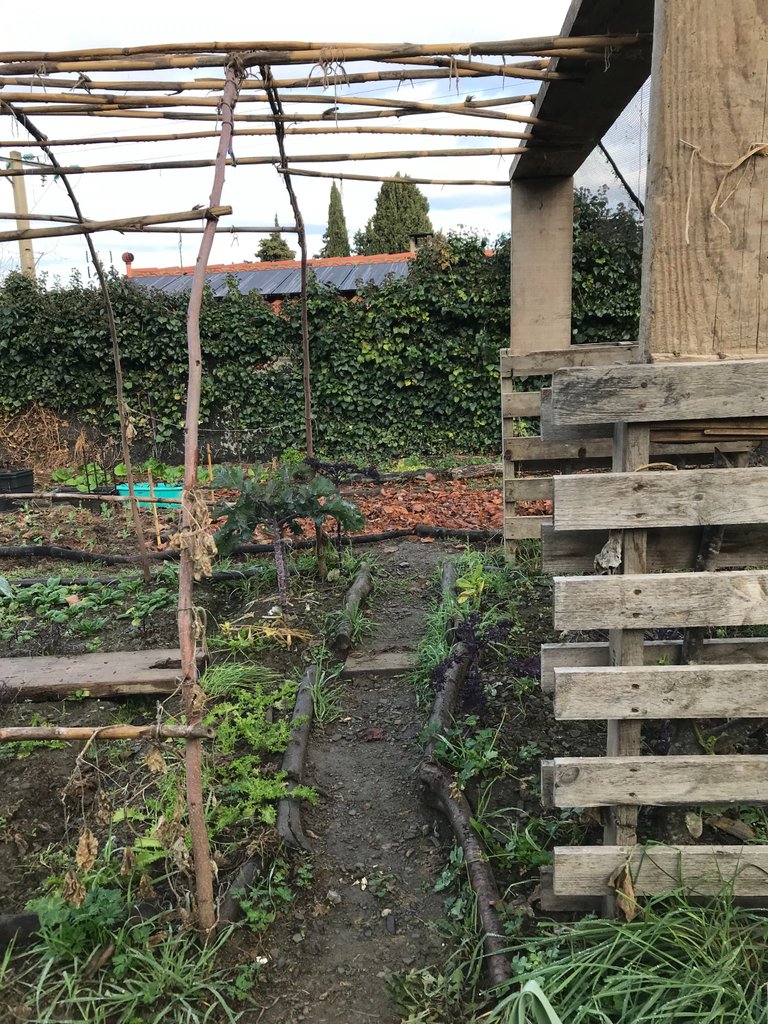
In the end it was decided to avoid involving the pallets and create the entrance where this path is.

I had to move the chives and a few kale & lettuce to dig the entrance hole.
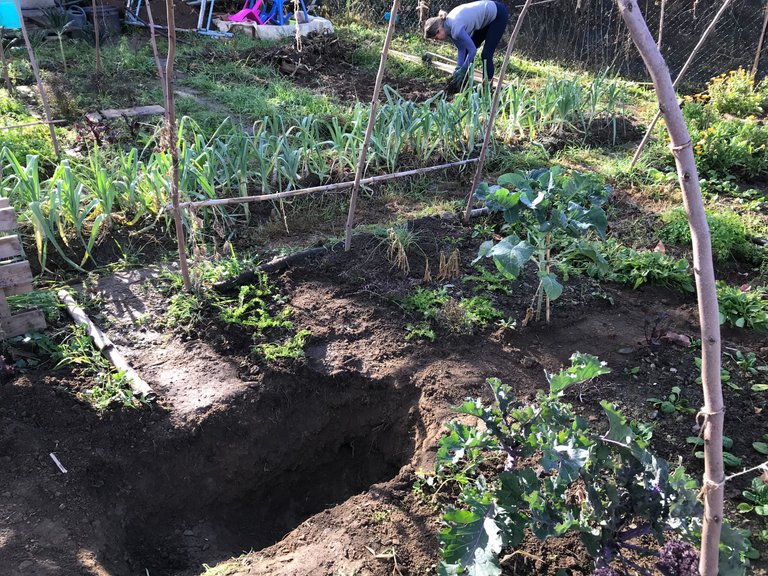
While meditating on this design I saw that the simplest and most secure way was to wrap it tight like a Christmas present. With this design however I have no choice but to dig down into the earth to create my entrance.
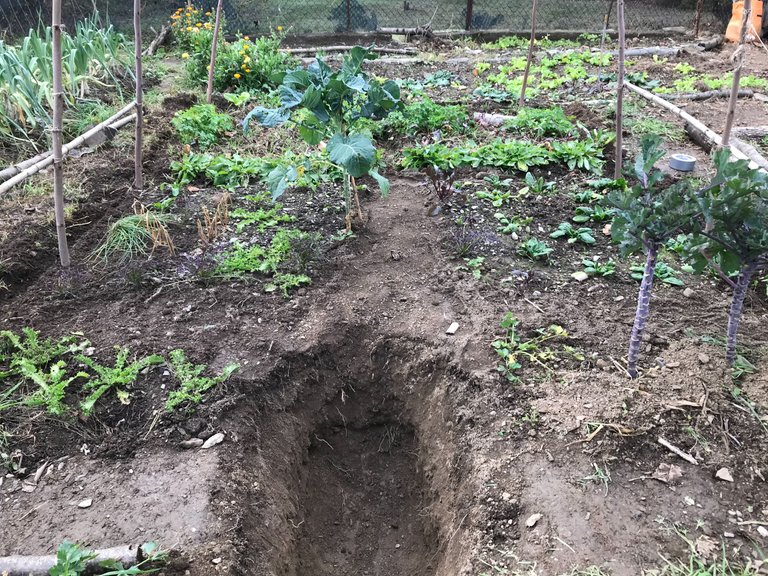
Here's me checking if the hole is big enough to crawl through without disturbing the structure too much.
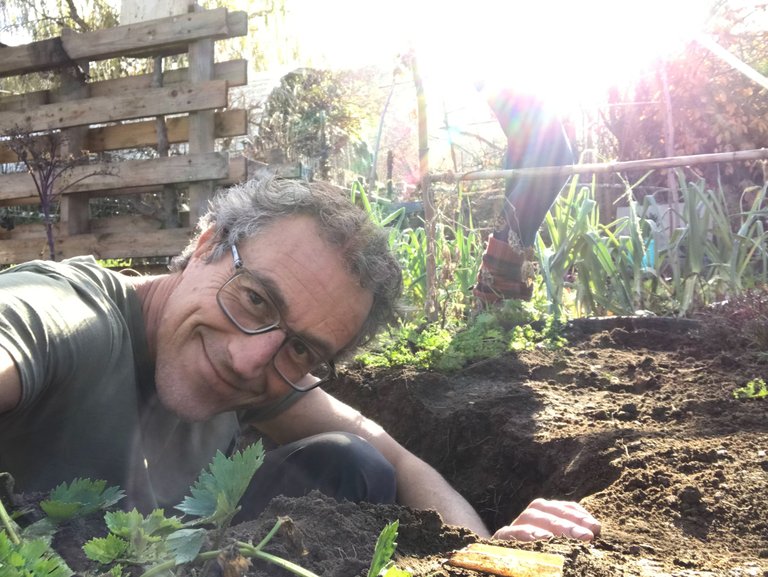
After this I dug little holes around the edges. These will be important later.
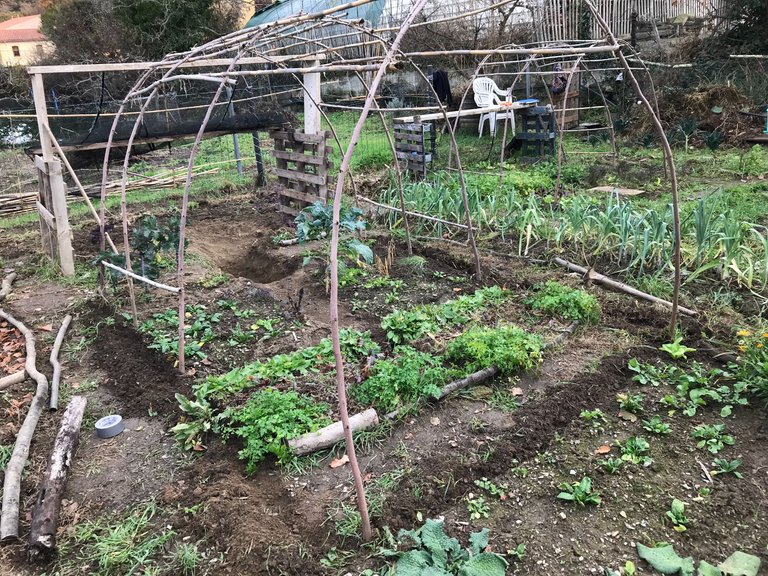
Getting started now with the plastic wrap I cover a section at the top.

This is important because you cannot wrap the top when you start from the bottom. It just won't work. Top needs to be done first.
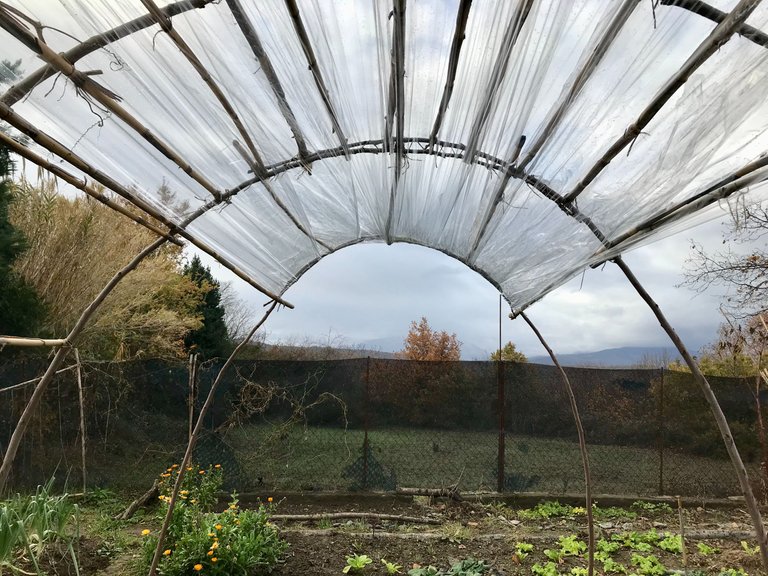
It also means that the roof layer will be under the wall layer, so when it rains the water should drip down all along the edges of the top, watering the plants inside the structure.
Next we start again with the plastic from the bottom.
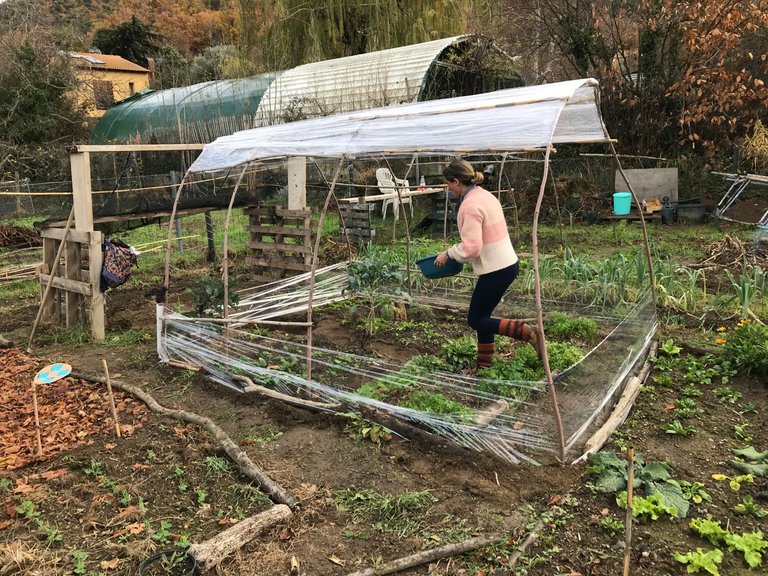
Using the holes we dug earlier, branches & earth are added to hold down the cling film in case of high winds.
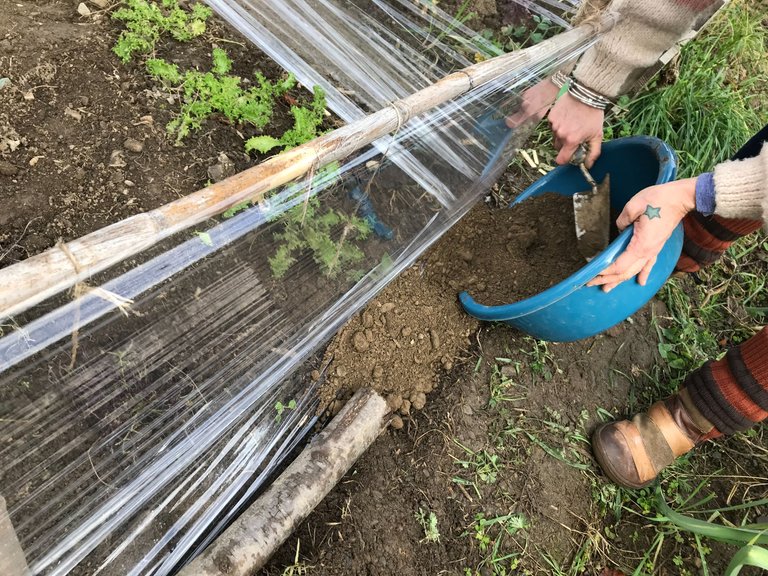
Don't want any heat being lost around these edges.
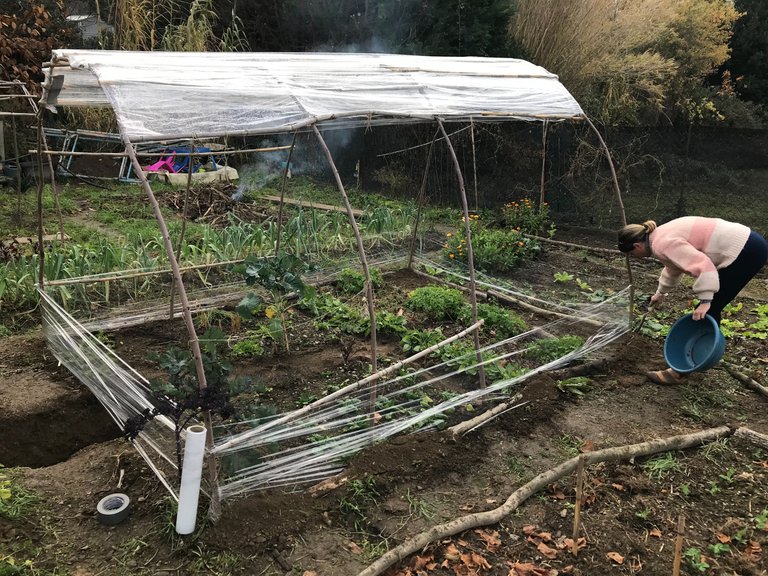
Up we go with the wrapping, keeping it tight and solid.
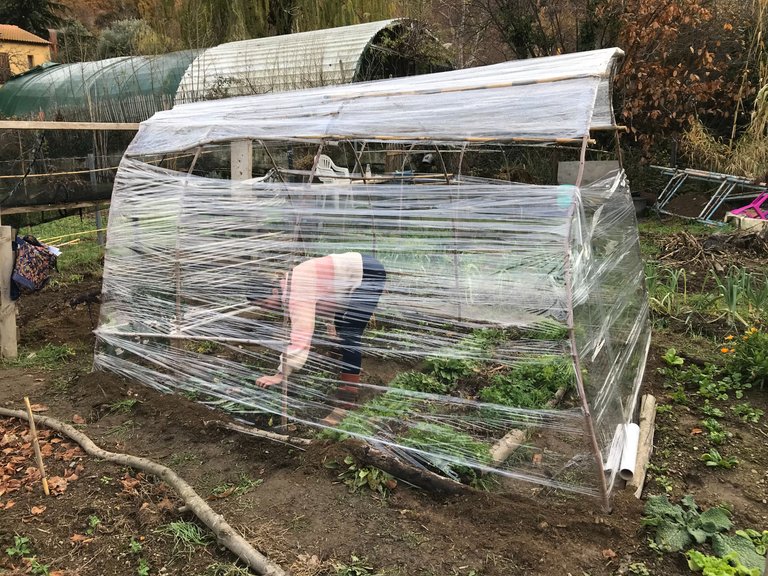
The last past wasn't easy due to the angle, but with two people it is achievable.
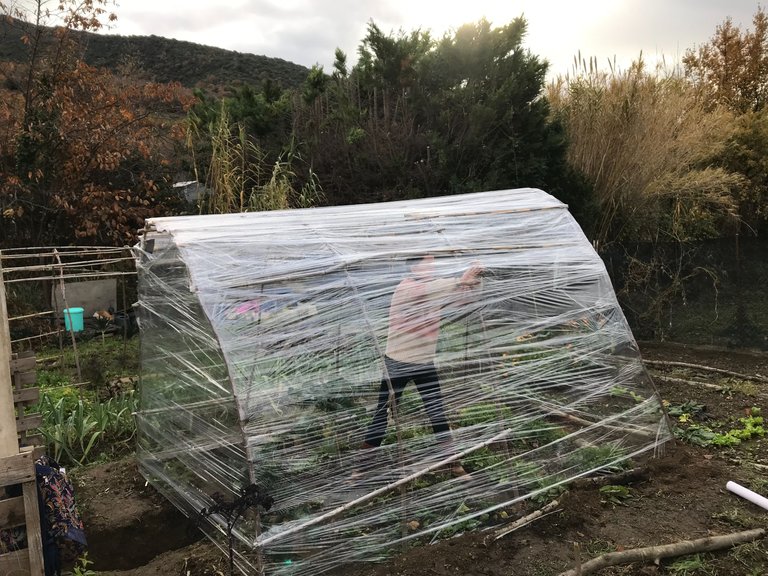
The extra pressure of the plastic wrap has changed the shape of the arch.
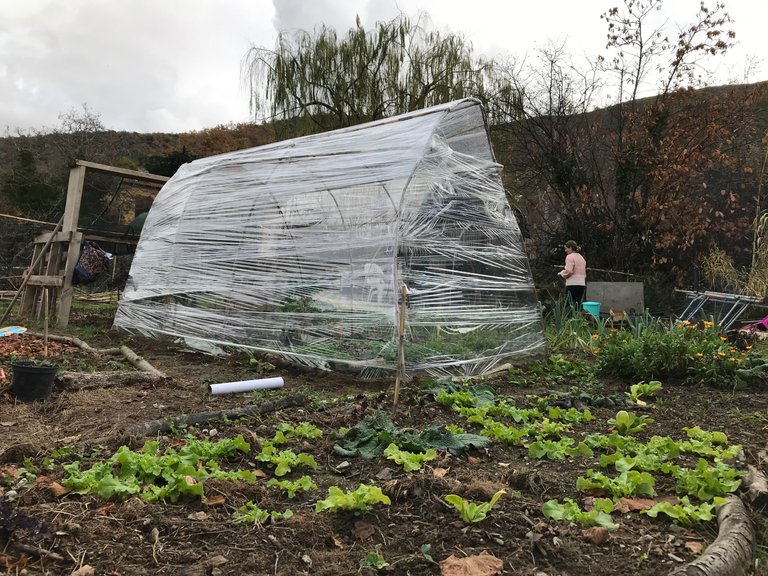
Looks more like a pyramid now! Plenty of headroom at least.
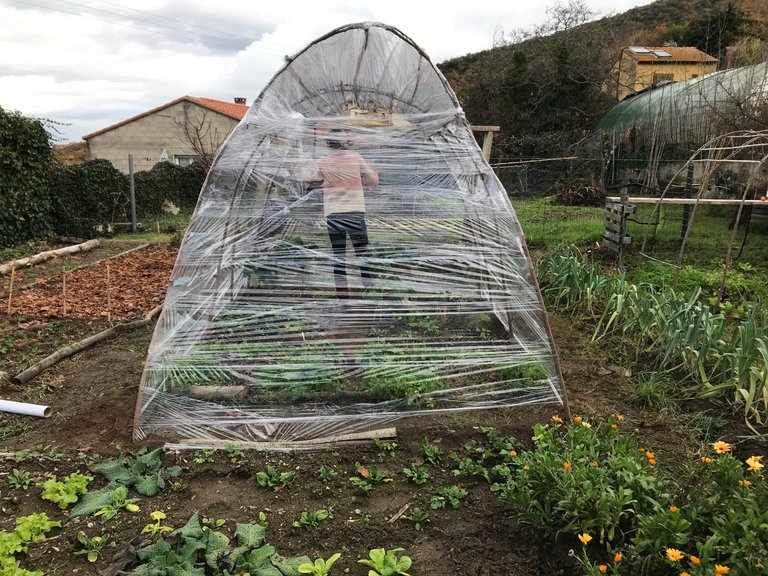
It is instantly warmer in here and the smell is amazing. I can smell the earth so clearly for the first time!
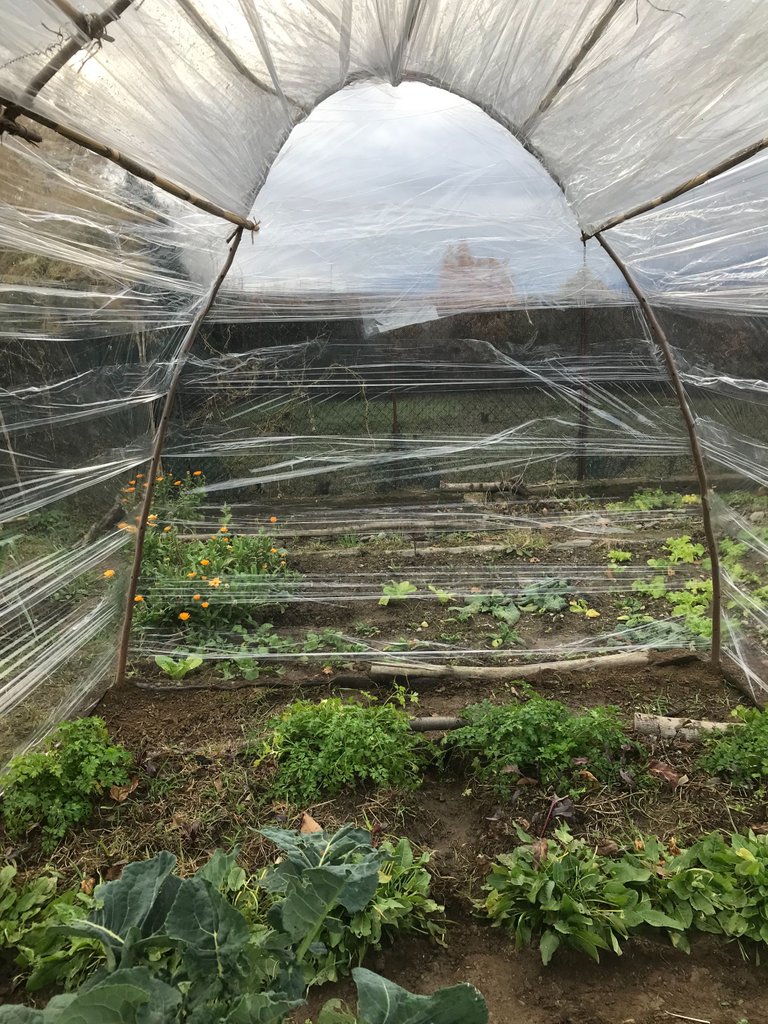
Down at the end there I have parsley, beetroot & sorrel but just beyond them I intend to put loads of pots, seedlings like tomatoes which can get a head start of at least a month or two.

Over here I have spinach and a few other little things like beetroot, rocket, mustard, coriander and dill.
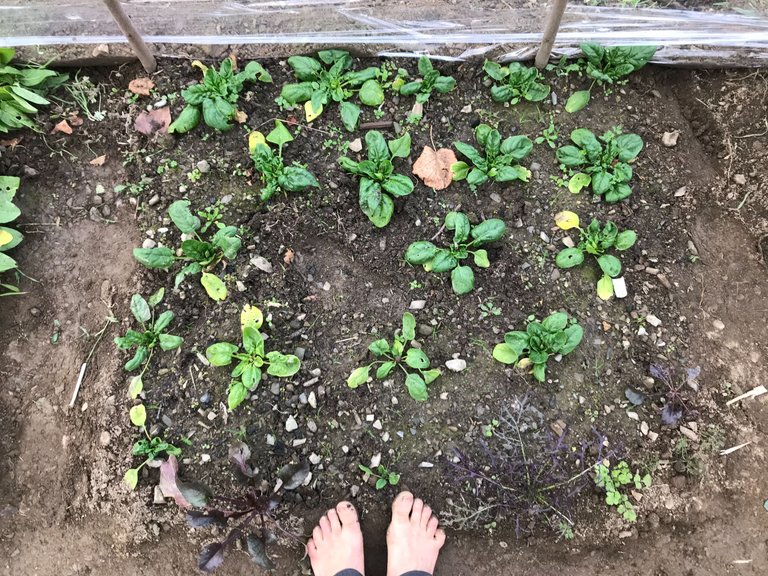
These kale (which recently had their growing points removed to encourage spring growth from the sides) should theoretically go crazy now.
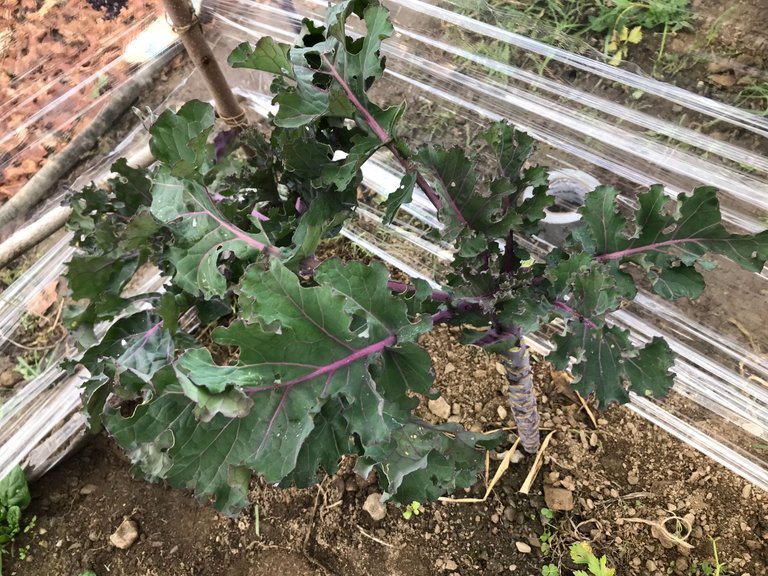
Their purple sister was just outside the plastic boarder and should make for an interesting comparison.
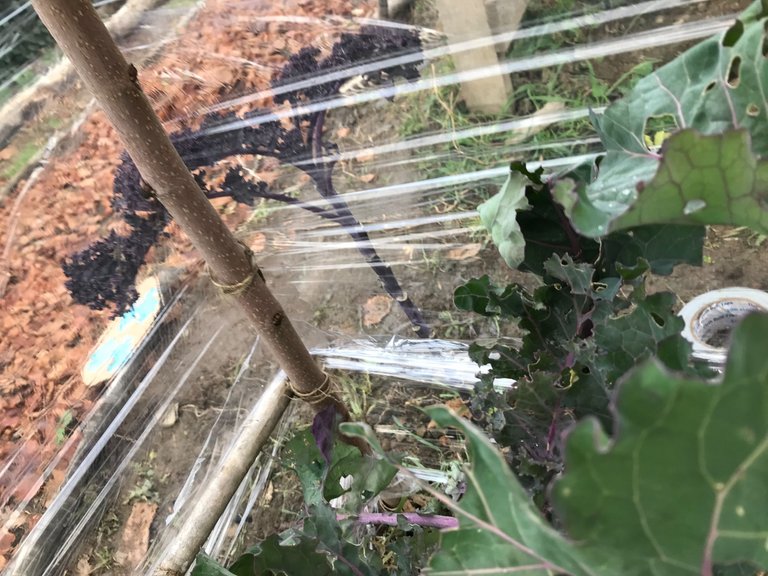
These are the chives I had to move. They will recover quickly with the increased temperature of the greenhouse.
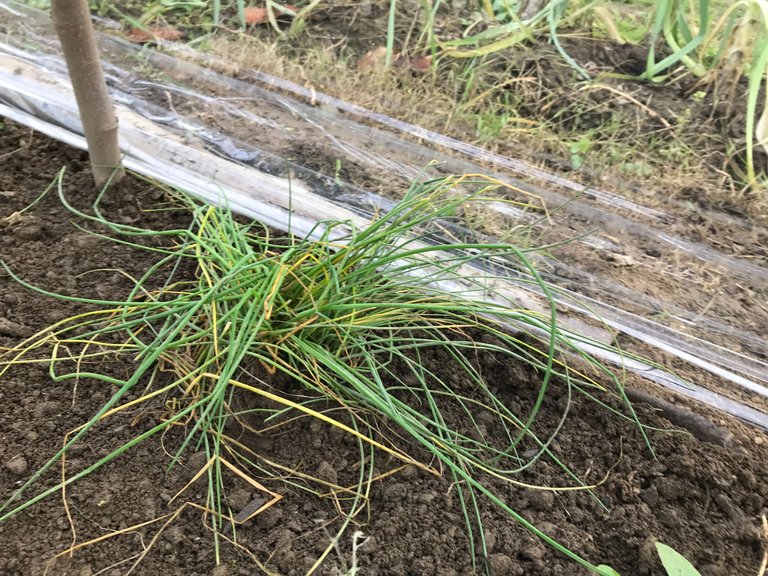
Next to the chives I have some lettuce, some purple mustard and the remains of a ginger plant which doesn't like the cold. The roots will be fine however and I now expect to the ginger to grow back at a much faster rate than it would have done without the greenhouse.
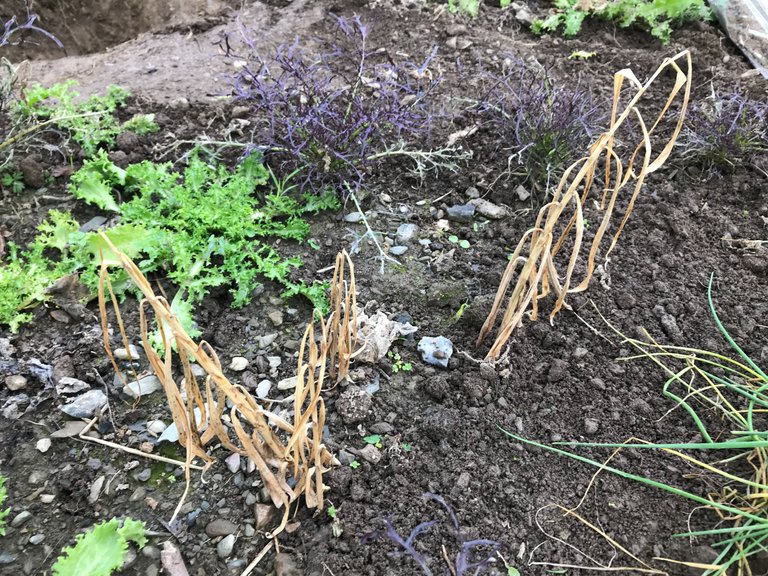
To keep the heat in at night I found this piece of wood for the hole. Needs to be a bit bigger really but it will do for now.
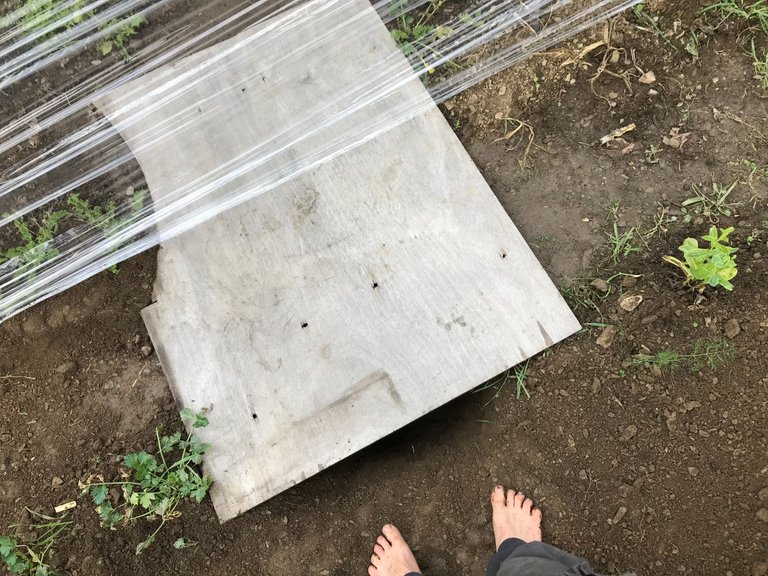
Cats can still get in there (there are many around here) but they won't be able to enter the greenhouse to dig anything up.
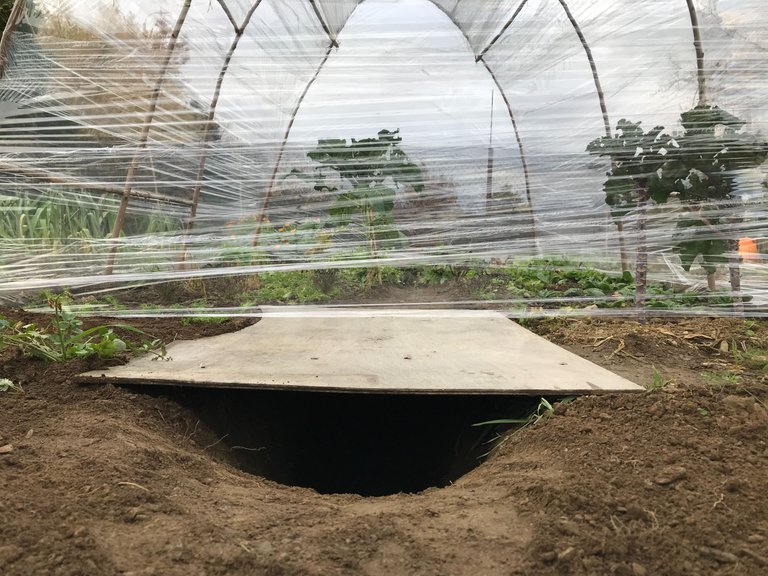
Feeling pretty good about this really. Seems solid and only took a few hours.

We still have a second structure seen here but it is too much in the shade at this time of year to be an effective greenhouse.
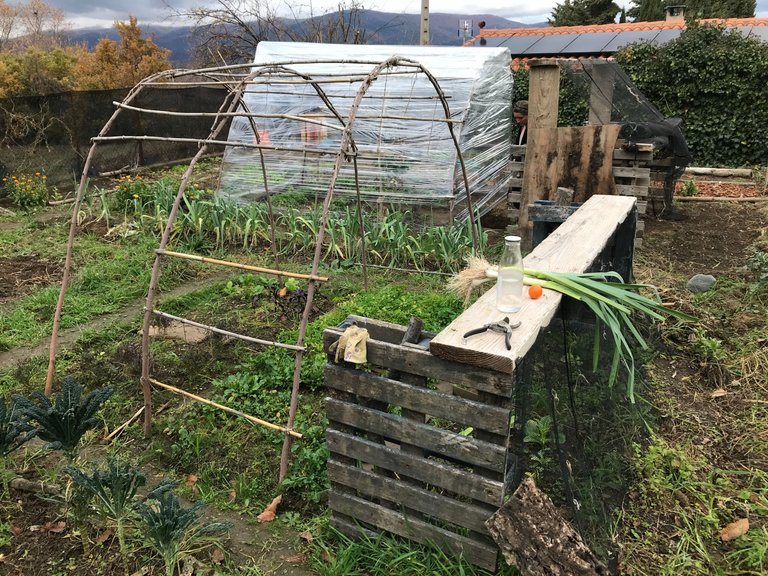
When we went back the following evening (after a night of heavy rain) everything looked fine and it was super warm & humid in there.
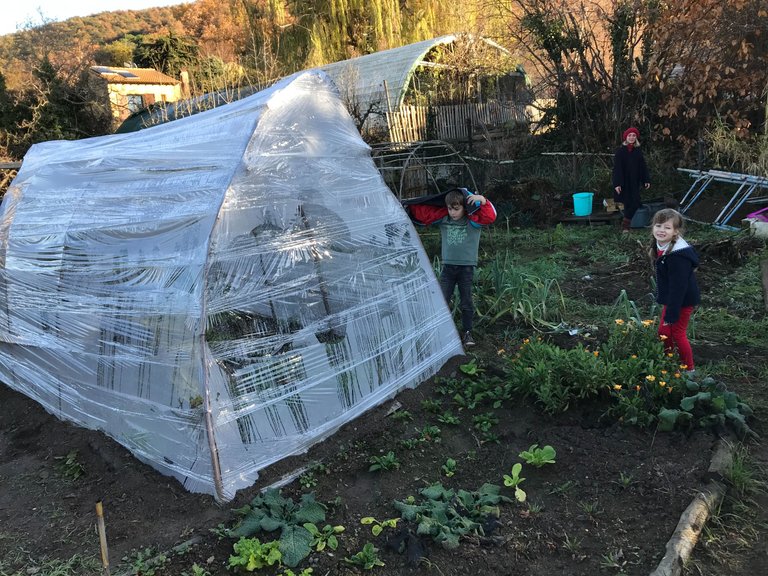
Which was very exciting for the little people!
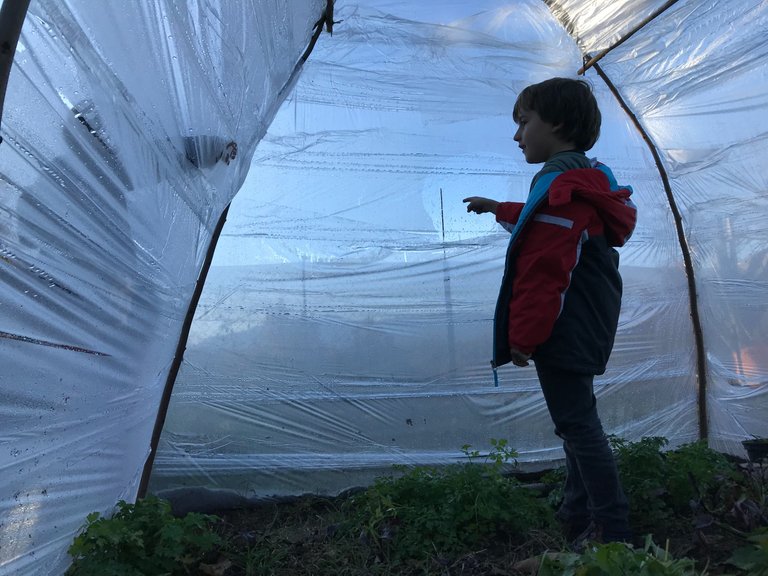
So that's it I suppose.
One greenhouse good to go.
The wind will be the real test of course...
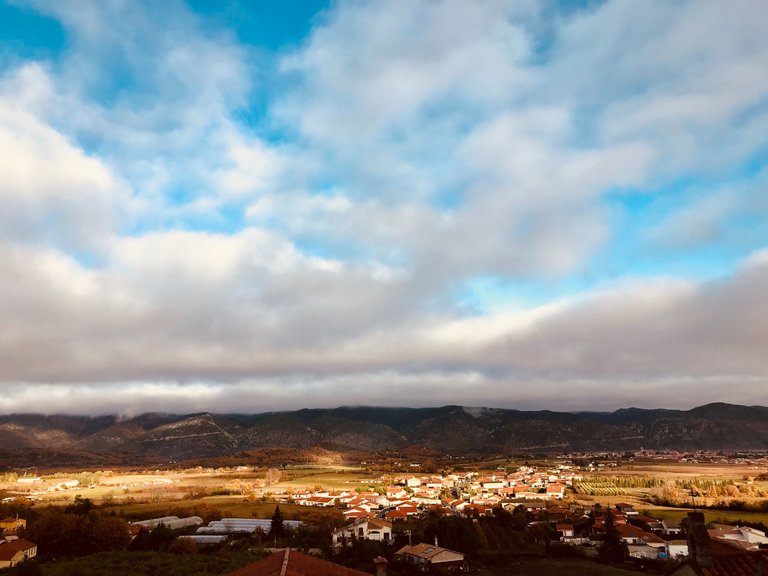
Final thoughts
If I could re-wind one year back to the point when this land was empty I would design it all differently, with electroculture techniques in mind. For one thing these shade/greenhouse structures would have been placed in alignment with north & south, permitting for magnetised steel cables to run under the earth, all the way through them, massively enhancing the growth of the plants there.
The whole garden would have been designed with sacred geometry in mind placing 51° cones at nodal points to create an energy grid, focusing plant growth on the lines between the nodes. Ideally one would seek a dowser to identify already existing energetic lines, incorporating them into their final design.
I have in fact ordered a bunch of electroculture equipment (couldn't help myself!) which will force me to re-design things to a certain extent, but I am happy at least to know that the greenhouse problem has been solved and we are now able to start seedlings early and make the most of the 2023 summer season which is going to be MEGA.
Love & Light everyone 🌱
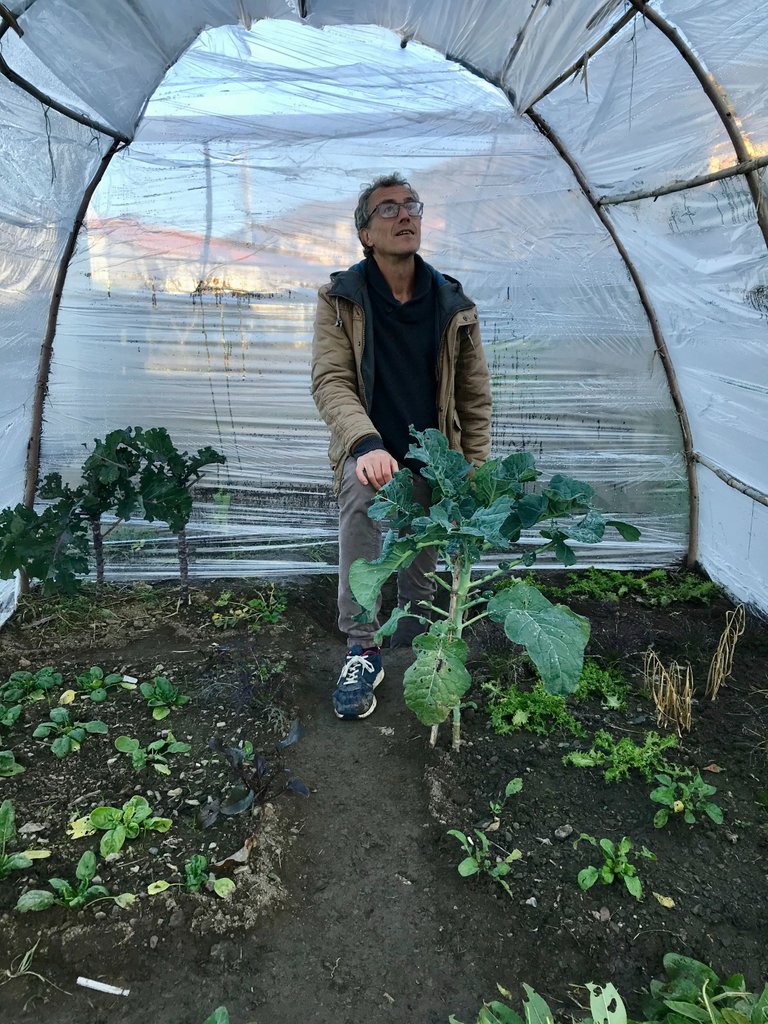
So sad for the purple kale left out in the cold 😰 but a good comparison, as you say.
Not sure you have room for it in there, but a barrel (or even a bucket) of water can act as a thermal mass to help the temp stay normalised when there a sudden swings.
Would be interesting to compare water in a bucket outside vs the same amount inside. 🤔
I'm pretty sure Mr purple kale doesn't care about being left outside. They all seemed content in the cold, though their growth is very slow. Likely faster in the greenhouse!
Had to look up the thermal mass system to fully understand what you mean and wow! Looks fab. But like you say, not too much room left in my greenhouse for a load of water. I could potentially move a few plants to make way for buckets. Let's see what kind of temperatures we are getting in the depths of winter. For now it is very mild and it probably needs more ventilation!
I was thinking to put a thermometer in there which records highs & lows. Ideally I would have two in fact, one inside, one out. This way I will know for sure how effective it is. But perhaps the bucket of water comparison is simpler! If the one outside freezes while the inside one doesn't, job done.
It has been a practical and very ingenious solution. I hope you get very good results.
Thanks. So far so good...
This allows gardeners to grow vegetables and fruits all year round, regardless of their location. Really good idea .Greenhouses offer several advantages over outdoor gardens. They are usually much less expensive than purchasing land outside your home; they require less maintenance than an outdoor garden.
Well, this kind of structure won't last a super long time. So I'm not sure it will work for everyone, but certainly for most people in Europe.
Stay tuned around Spring time and I will make a post to report on how it went.
It's a lot of work, but definitely necessary due to inclement weather, but it's an excellent and economical option. I hope you have a lot of success!
Thanks! Fingers crossed for a winter without too many storms...
Looks great. I am looking for a cheap greenhouse option in a similar area. How does the clingfilm react on freezing nights? Some clingfilm loses its sticky strength.
I've done zero research on this one so all I can really tell you is that it survived its first night! I will do an update in a month and report on how it looks. But I think, due to the way we wrapped it so tight, it will be fine through most weather conditions. The wind is my main concern because it is EXTREME around here sometimes. And we've not had a decent storm for ages.
I will be so interested to know how the greenhouse survives the wind and sun. Hope it works as well as you hope...
Good point. The cling film isn't really designed to be in the sun, so this may affect it too. Will keep the reports coming to let you know how she fares against the elements, but I'm confident she will last till March, at which point I can remove the sides and just leave the top on for the last month, in case of late snow or frost. I remember we had snow on 1st April last year...
Great work Sam! That is a great greenhouse on a budget!
Well, time will be the real test. But for now I am feeling great about this design! It only needs to hold together for around three months, so let's see...
I appreciate you for being so good in creating something for your plants. This is very helpful to them to grow well. Thanks for sharing this technique.
No worries. Good luck with your plants.
Thank you for sharing this post on HIVE!
Your content got selected by our fellow curator sharminmim & you just received a little thank you upvote from us for your great work! Your post will be featured in one of our recurring compilations which are aiming to offer you a stage to widen your audience within the DIY scene of Hive. Stay creative & HIVE ON!
Please vote for our hive witness <3
Thanks for the curation.
I was thinking "what's about the door?!" ...and you answered that one in a way I had not thought of! Letting the rain in is great benefit that "real" greenhouses can't offer. I imagine the plastic will last one season... (probably) replace each winter... :)
Yes, I don't expect the plastic to last more than three or four months really (that's all I need) but I do have a second life in mind for it. Nothing goes to waste around here...
I suggest some kinda fence-post-depth stakes tied to all four corners to beat the wind.... Needs to be anchored or it will blow awayyyy... I've seen trampolines blow away in heavy wind...
Our trampoline blew away the first week we had it! And it squished a bunch of plants while it rolled away. So yes, I already learned this the hard way. Am more confident with this structure because the hazelnut wood arches have been dug deep into the ground. Let's see...
I will try to do what you did with your pumpkin! ^_^
Good man! Have fun :)